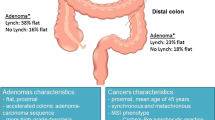Abstract
With hereditary colorectal cancer prevention studies it is difficult to demonstrate reduced mortality. Large populations are needed with well characterized genetics followed over a long period of time. Those studies do exist for standard white light colonoscopy surveillance in Lynch syndrome, but not for newer technologies including chromoscopy. For these newer technologies adenoma detection rate becomes the stand-in for mortality, and the assumption is made that surveillance efficacy impacts cancer occurrence. Though well-designed and important work exists in this area, the data do not support firm conclusions regarding the use of chromoscopy in Lynch syndrome.
Similar content being viewed by others
References
Barrow E et al (2009) Colorectal cancer in HNPCC: cumulative lifetime incidence, survival and tumour distribution. A report of 121 families with proven mutations. Clin Genet 74:233–242
Rondagh EJ, Gulikers S, Gomez-Garcia EB, Vanlingen Y, Detisch Y, Winkens B, Vasen HFA, Masclee AAM, Sanduleanu S (2013) Nonpolypoid colorectal neoplasms: a challenge in endoscopic surveillance of patients with Lynch syndrome. Endoscopy 45(4):257–264
Vasen HFA, Abdirahman M et al (2010) One to 2-year surveillance intervals reduce risk of colorectal cancer in families with Lynch syndrome. Gastroenterology 138:2300–2306
Jarvinen HJ, Aarnio M, Mustonen H, Aktan-Collan K, Aaltonen LA, Peltomaki P, De La Chapelle A, Mecklin JP (2000) Controlled 15-year trial on screening for colorectal cancer in families with hereditary nonpolyposis colorectal cancer. Gastroenterology 118:829–834
de Vos tot Nederveen Cappel WH, Nagengast FM, Griffioen G (2002) Surveillance for hereditary nonpolyposis colorectal cancer: a long-term study on 114 families. Dis Colon Rectum 45(12):1588–1594
Mecklin JP, Aarnio M, Laara E, Kairaluoma MV, Plyvanainen K, Peltomaki P, Aaltonen LA, Jarvinen JV (2007) Development of colorectal tumors in colonoscopic surveillance in Lynch syndrome. Gastroenterology 133:1093–1098
Engel C, Rahner N et al (2010) Efficacy of annual colonoscopic surveillance in individuals with hereditary nonpolyposis colorectal cancer. Clin Gastroenterol Hepatol 8:174–182
National Comprehensive Cancer Network: NCCN guidelines. http://www.nccn.org/professional/physician_gls/pdf/genetics_colon.pdf. Accessed 18 Nov 2015
American Gastroenterological Association: guidelines. http://gastro.org/guidelines/2015/10/19/diagnosis-and-management-of-Lynch-syndrome. Accessed 18 Nov 2015
American College of Gastroenterology: clinical guidelines. http://gi.org/guideline/guidelines-on-genetic-evaluation-and-management-of-lynch-syndrome-a-consensus-statement-by-the-us-multi-task-force-on-colorectal-cancer/. Accessed 18 Nov 2015
Subramanian V, Ragunath K (2014) Advanced endoscopic imaging: a review of commercially available technologies. Clin Gastroenterol Hepatol 12(3):368–376
ASGE Technology Committee (2015) Endoscopes and devices to improve colon polyp detection. Gastrointest Endosc 81(5):1122–1129
Sharma P, Gupta N, Kuipers EJ, Repici A, Wallace M (2014) Advanced imaging in colonoscopy and its impact on quality. Gastrointest Endosc 79(1):28–36
Cochrane Library. http://cochranelibrary.com/cochrane-database-of-systematic-reviews/index.html. Accessed 18 Nov 2015
East JE, Suzuki N, Guenther T, Thomas HJW, Saunders BP (2008) Narrow band imaging for colonoscopic surveillance in hereditary non-polyposis colorectal cancer. Gut 57(1):65–70
Hurlstone DP, Karajeh M, Cross SS, McAlindon ME, Brown S, Hunter MD, Sanders DS (2005) The role of high-magnification-chromoscopic colonoscopy in hereditary nonpolyposis colorectal cancer screening: a prospective “back-to-back” endoscopic study. Am J Gastroenterol 100:2167–2173
Lecomte T, Cellier C, Meatchi T, Barbier JP, Cugnenc PH, Jian R, Laurent-Puig P, Landi B (2005) Chromoendoscopic colonoscopy for detecting preneoplastic lesions in hereditary nonpolyposis colorectal cancer syndrome. Clin Gastroenterol Hepatol 3:897–902
Stoffel EM, Turgeon DK et al (2008) Missed adenomas during colonoscopic surveillance in individuals with Lynch syndrome (hereditary nonpolyposis colorectal cancer). Cancer Prev Res 1(6):470–475
Rahmi G, Lecomte T et al (2015) Impact of chromoscopy on adenoma detection in patients with Lynch syndrome. Am J Gastroenterol 110(2):288–298
Author information
Authors and Affiliations
Corresponding author
Ethics declarations
The manuscript is a review and did not involve direct patient interactions.
Conflict of interest
The authors declare that they have no conflict of interest.
Rights and permissions
About this article
Cite this article
Jenkins Wessling, E., Lanspa, S.J. Colonoscopy and chromoscopy in hereditary colorectal cancer syndromes. Familial Cancer 15, 453–455 (2016). https://doi.org/10.1007/s10689-016-9881-9
Published:
Issue Date:
DOI: https://doi.org/10.1007/s10689-016-9881-9




